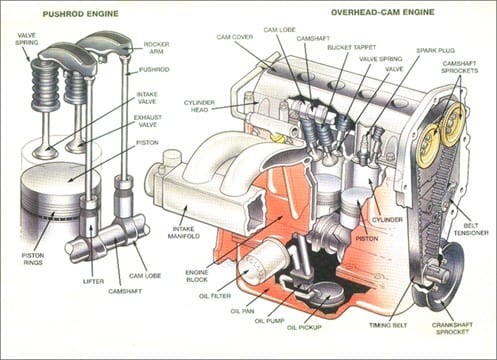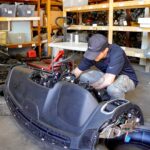Just like the human heart is vital for the body, the engine is the heart of your car. Its primary function is to convert fuel into motion, enabling your vehicle to move. This conversion happens through a process called internal combustion, essentially a series of controlled mini-explosions that generate power. While often seen as a single unit, a car engine is actually a complex assembly of numerous components working in perfect harmony. Understanding the Parts Of Car Engine and their roles is crucial for every car owner. Let’s delve into the essential components and their functions.
 Diagram of Car Engine Parts: Exploring the Anatomy of Your Vehicle's Power Source
Diagram of Car Engine Parts: Exploring the Anatomy of Your Vehicle's Power Source
Car engines are built around robust, sealed metal cylinders. Most cars today utilize engines with four to eight cylinders, though some high-performance vehicles can boast up to twelve or even sixteen. These cylinders are precisely engineered to open and close at exact moments, allowing fuel to enter, mix with air for combustion, and then expel the resulting exhaust gases. While a car engine comprises many parts, we’ve compiled a list of the most critical parts of car engine and their functions, that power your vehicle. Refer to the diagram to visualize their placement within the engine.
-
Engine Block: Consider the engine block as the foundational structure of your engine. Typically constructed from aluminum or cast iron, it’s a robust framework containing the cylinders and passages for coolant and oil circulation, vital for engine cooling and lubrication. Oil pathways are designed to be narrower than coolant passages. The engine block is also the housing for key components like the pistons, crankshaft, and camshaft, and accommodates the cylinders – typically four to twelve – arranged in configurations such as inline, flat, or V-shaped, depending on the vehicle’s design.
-
Pistons: Pistons are cylindrical components with a flat top surface, playing a crucial role in power transmission. Their primary function is to transfer the energy generated from combustion to the crankshaft, which ultimately propels the vehicle. Pistons move up and down within the cylinders twice for every crankshaft rotation. In an engine operating at 1250 RPM, each piston completes this up-and-down cycle 2500 times per minute. Piston rings, located within the pistons, are essential for maintaining cylinder compression and minimizing friction caused by the constant movement against the cylinder walls.
-
Crankshaft: Situated in the lower section of the engine block, within crankshaft journals (bearing surfaces), the crankshaft is a precisely crafted and balanced component. It connects to the pistons via connecting rods. Much like a jack-in-the-box mechanism, the crankshaft converts the pistons’ linear up-and-down motion into a rotational motion, operating at engine speed. This rotational force is then transmitted to the vehicle’s transmission system.
-
Camshaft: The location of the camshaft can vary depending on the vehicle, sometimes found within the engine block and sometimes in the cylinder heads. Modern engines often feature camshafts in the cylinder heads, known as Dual Overhead Camshaft (DOHC) or Single Overhead Camshaft (SOHC) configurations. These are supported by bearings lubricated with oil for durability. The camshaft’s role is to regulate the timing of valve opening and closing. It takes the rotational motion from the crankshaft and converts it into a reciprocating motion, which controls the movement of lifters, pushrods, rockers, and ultimately, the valves.
-
Cylinder Head: Attached securely to the engine block with cylinder bolts and sealed with a head gasket, the cylinder head is a complex component. It houses numerous parts, including valve springs, valves, lifters, pushrods, rockers, and camshafts. The cylinder head manages the intake and exhaust processes, controlling pathways that allow air to enter the cylinders during the intake stroke and exhaust gases to exit during the exhaust stroke. The head gasket creates a critical seal between the engine block and cylinder head, preventing leaks and maintaining compression.
-
Timing Belt/Chain: Synchronization between the camshaft and crankshaft is essential for proper engine operation and timing. This synchronization is achieved by either a timing belt or a timing chain. The timing belt is made from durable rubber with teeth that mesh with pulleys on the camshaft and crankshaft. The timing chain, similar to a bicycle chain, wraps around toothed pulleys. Both ensure precise valve timing in relation to piston movement, which is critical for efficient combustion and engine performance.
Common Engine Issues
Given the intricate nature of engines and the high speeds at which these parts of car engine operate, wear and tear over time is inevitable. This wear can lead to various engine problems, often manifesting in changes in your car’s behavior. Here are some common engine problems and their associated symptoms:
-
Poor Compression: This often results in reduced engine power, engine misfires, or the engine failing to start. Poor compression can be caused by worn piston rings, valve issues, or cylinder damage.
-
Cracked Engine Block: A crack in the engine block can lead to serious issues such as engine overheating, white smoke from the exhaust (due to coolant burning), and coolant leaks, often visible on the engine’s exterior. Overheating is a primary symptom.
-
Damaged Pistons, Rings, and/or Cylinders: Symptoms of damage in these parts of car engine include rattling noises, blue smoke emanating from the exhaust pipe (indicating oil burning), a rough engine idle, and potential failure to pass emissions tests.
-
Broken or Worn Rods, Bearings, & Pins: These issues can produce tapping or ticking sounds from the engine, low oil pressure readings, metal shavings found in the engine oil during an oil change, or rattling noises specifically when accelerating.
Car engines, while seemingly intricate, have a fundamental purpose: to propel your vehicle. With so many parts of car engine working in concert to generate motion, regular and proper vehicle maintenance is paramount to ensure their longevity. Routine oil changes, scheduled fluid flushes, and timely replacement of belts and hoses, as recommended by your vehicle’s manufacturer, are vital steps in preventing major engine failures.
For expert engine maintenance and repair services, consider professional automotive service centers. When choosing a service provider, prioritize trust, honesty, and quality workmanship. Reputable centers often employ certified technicians and offer warranties on their services, providing peace of mind and ensuring customer satisfaction. Seeking dealership-level service at reasonable prices is achievable by choosing a well-regarded and customer-focused auto service provider.

